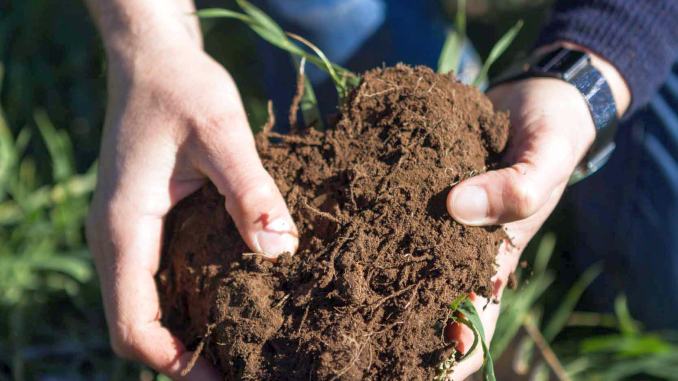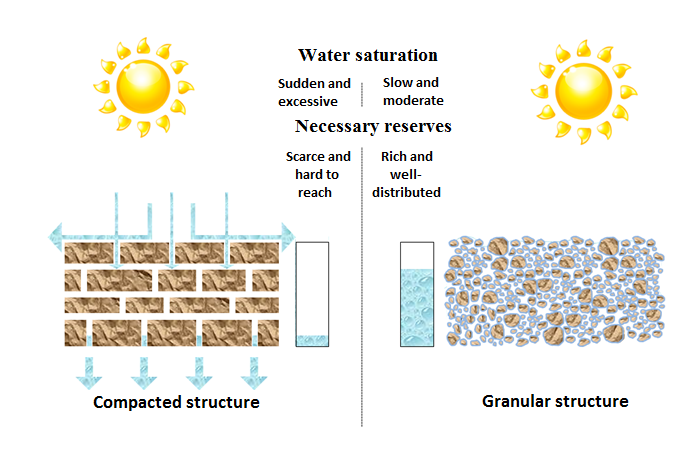 Because the beginning matters most. More precisely, the structure of the soil influences fertility, an essential factor when it comes to the productivity of that soil.
Because the beginning matters most. More precisely, the structure of the soil influences fertility, an essential factor when it comes to the productivity of that soil.
Basically, a well-structured soil is a soil whose porosity is approximately 50% of its mass. Out of this 50%, 30-35% is water, while 15-20% is air. In this soil, the conditions are optimal for plant growth and development: the airhydric, thermal and nutritional conditions, the mineralization and humification.
In other words, if the soil has a granular structure, water infiltrates more easily and it is stored more efficiently between the aggregates (on full depth). Thus, in the case of this structured soil, water reaches the groundwater with ease and remains trapped between the soil particles, filling the empty spaces between these particles and preventing the loss of water by evaporation. All water drops trapped between the particles have roughly the same dimensions, and capillarity only appears at a depth of 0-20 cm, in the surface layer of soil which is practically a complex “blanket”, an actual compost.
A structural soil (with a granular structure) should be a must in the technology used in every type of culture. Whether we are talking about maize, soy, alfalfa, sunflower, sugar beet, rape, cereal, sorghum, vegetable or floral farming, greenhouses and hothouses, all these need a soil that the root system can penetrate easily, thus exploiting a much larger volume of soil. This results in a process of storage of water and nutritional elements which is highly superior compared to a compacted soil structure.
Moreover, in this structural soil, the activity of microorganisms is intense, leading to a rapid decomposition of plant debris which eventually results in the production of humus, whose presence has diminished in most soils.
Another reason is that structural soil can be easily worked. Think about ploughing or scarifying, when the turned soil virtually crumbles – compared to the compacted soil, in which the furrow or the soil conglomerates remain intact upon mechanical processing. What does a structural soil imply? Very simply put:
- Work done “by the book”
- Shallow ploughing done at the same time as deep ploughing
- Significantly diminished consumption of fuel
- Increased resistance of machinery parts (component parts of the ploughs, scarifiers and disks that come in contact with the soil), which we do not have to change as often as before
- Reduced compaction of the soil we are working on.
What does a compacted soil imply?
The spaces between the particles are filled. Basically, there are no flocculation processes, but only coagulation processes are taking place. Thus, the water resulting from precipitation reaches the superficial layer and the air between the particles is thus eliminated, resulting in saturation. For this particular reason, in late winter or early spring cereal (wheat, barley) appear yellow-brownish instead of green. The explanation of this phenomenon lies in the fact that the superficial layer of 0-20 cm is filled with water, resulting in the saturation and ponding of the soil. Since the soil particles are virtually mixed with water, there is no air, which means that there is no microbial activity and no nutrients in the soil. As the weather gets warmer, the superficial layer dries up and microorganisms are activated, but there is no water. Therefore, the nutrition processes are dramatically slowed down. These soils are difficult to plough, they lose organic matter from one season to the next, their composition is over 30% clay and farmers cannot control the technological processes associated with ploughing (more precisely, one cannot know when to start working the soil).
The picture below illustrates what we mentioned above:

What is the ideal solution for obtaining a granular structure?
Soil aggregates formed from clay and humus enriched with TerraCalco® are durable, stable and elastic - those aggregates resume their initial shape after compaction (the “sponge” effect).
If applied before sowing (upon preparation of the germinative bed), or before a basic ploughing of the soil, TerraCalco® creates the perfect environment for the future plants’ development. It transforms the structure of the soil, which becomes loose and easy to prepare; the life of microorganisms and soil fauna is improved, the soil hardpan is loosened so that water can flow through it, and eventually production increases, whether it is a culture of maize, sunflower, soy, rape, wheat, peas, sugar beet, alfalfa, vegetables, goji berry, raspberry or many others.
At physical level, TerraCalco®:
- builds a positive soil structure by breaking bonds and aerating the soil
- creates the “sponge” effect in the soil
- the soil aeration is effective against wireworms (Agriotes Sp.)
- the created granular structure improves the efficiency of specific herbicides
- plant germination and development are significantly improved
- ponding disappears
- agrotechnical works are of superior quality
- fights the “soil fatigue” phenomenon
- the consumption of gas and damage of machinery parts are greatly reduced on that particular surface
Given its rapid reaction input, it can be used both in the spring campaign (January-April) as well as in the autumn campaign (June-December), depending on the culture to be sowed. The dosage is adjusted according to the agrochemical chart.
For more information on the topic, contact us.
